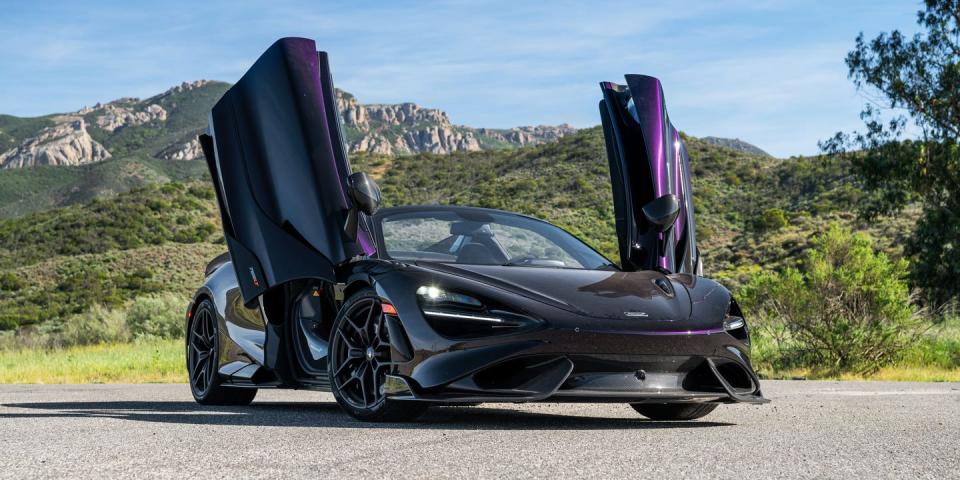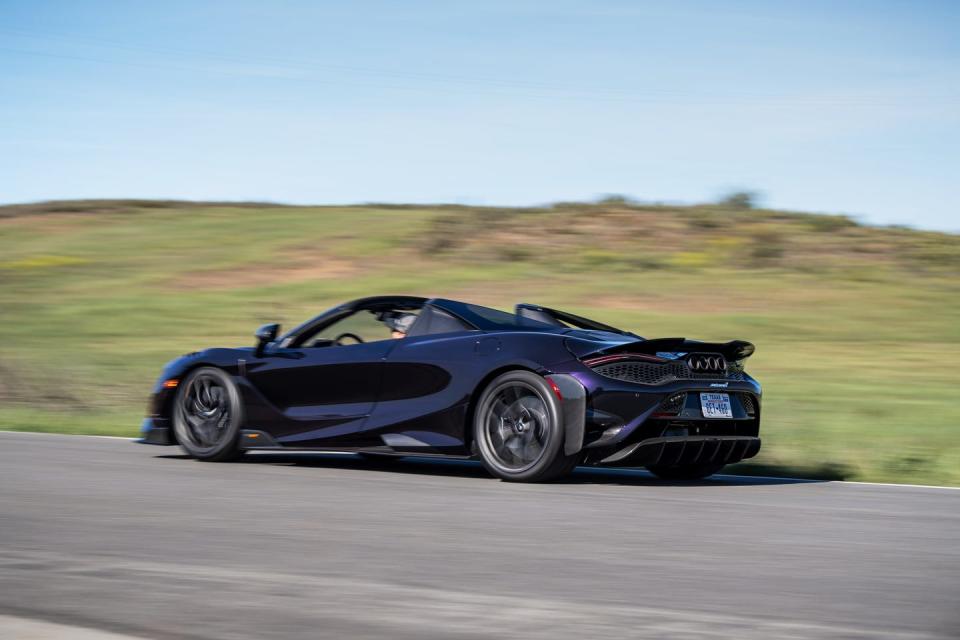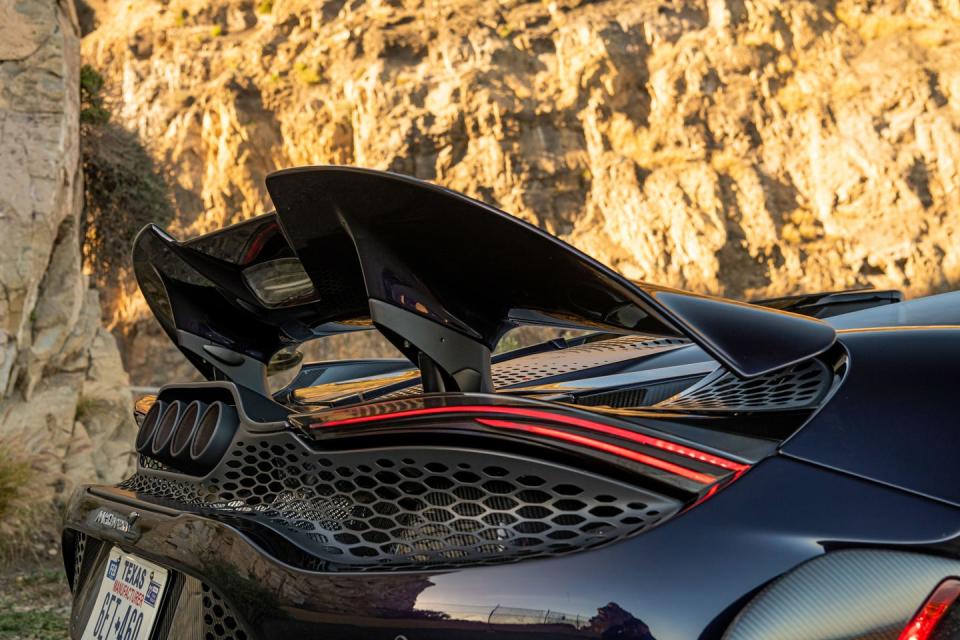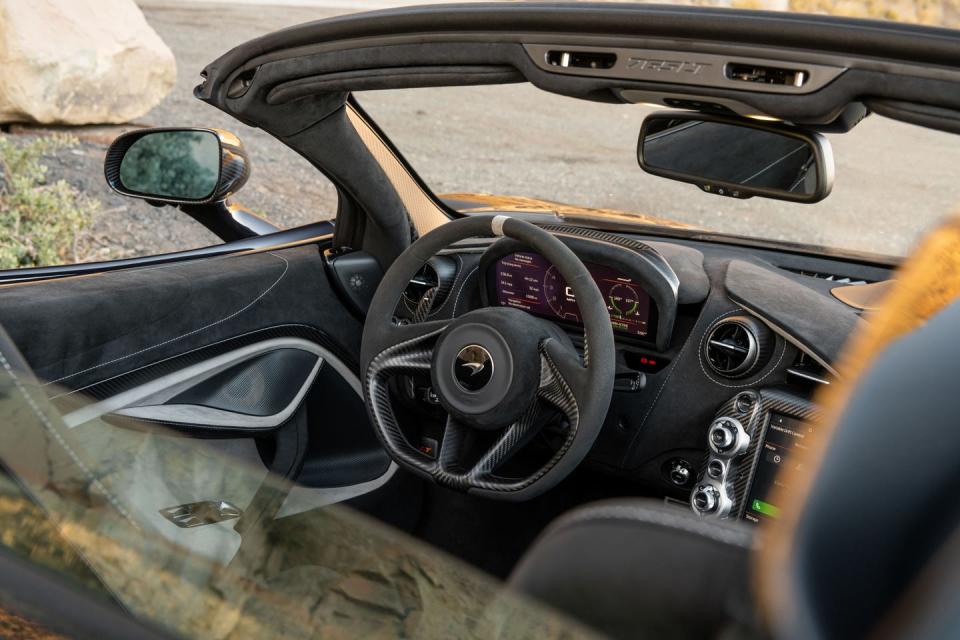2022 McLaren 765LT Spider Keeps 755 Horsepower Civilized, Barely

The 2022 McLaren 765LT Spider hits hard. Horsepower? Several herds worth, 755 equines stampeding from the twin-turbo 4.0-liter V-8. Torque? 590 pound-feet, enough to get your undies in a twist with you still in 'em. McLaren says it will do zero to 60 in 2.7 seconds, run a 10-second quarter-mile, and hit a top speed of 205 mph. We have no reason to doubt those claims for the convertible as the 765LT coupe version set a top-speed record during Lightning Lap 2021. The Spider is a tiny bit heavier and a tiny bit softer, but it's clear from the first fast corner that it's as quick and violent as you'd expect from a performance-focused upgrade of McLaren's well-rounded 720S.
What you might not predict from perusing the spec sheet is that the McLaren 765LT Spider can be driven through the mountains with one hand while crying. This is not normally part of our supercar testing procedure, but soft-close dihedral doors also hit hard when your fingers are in the way. Impressive latch on that car. If you're one of the cool Malibu teens who saw this happen, please don't post it on TikTok, we hurt enough as is. Thankfully, the cupholders are waterproof, which meant they could, and did, work as an impromptu ice bath for the drive home.

McLaren's LT models are spiritual successors to the F1 GTR Longtail, the recipe being to take an already-bonkers supercar, pull weight out, enhance the aerodynamics, pump up the power, and make the result somehow street-legal—and in the case of the 765LT, downright streetable. An F1 GTR would have been far more difficult to pilot with one fist in a cup of ice, what with the manual transmission and the center seating position and the notably firm steering. Our 1994 review of the F1 mentioned that it took both hands just to get into the driver's seat. The 765LT didn't love puttering through the hills at sobbing speed, but it stayed the course, no tramlining or lurching. It's also easier to get in and out of than an F1, both physically and financially. The base price is a cool $382,500, but the finger-chomping car we drove came with a $507,420 price tag, a bargain compared to the $20-plus mil you'd need to get close enough to an F1 to slam the door on your hand. But enough about that, we did have a full day in the Spider with both hands on the reins, and—boy howdy—this thing is a ride.
As its name suggests, the 765LT Spider is longer in the rear than a 720S. Only a smidge, though: The tail end grew by 0.4 inch, while the front gained 1.9 inches. Apparently, "McLaren Longnose" doesn't have the same marketing cachet. The elongated bodywork is tunneled and twisted like the inside of an anthill, every edge a stern command to nearby air molecules as to when they should enter, exit, and move along there, buddy. Hardcore aero isn't always pretty, but the 765LT has the hypnotic grace of a Utah slot canyon with its jutting front splitter, delicately bridged headlight sockets, cavernous door hollows, and honeycomb-pocked metal-mesh rear. One wants to explore its overhangs, spelunk in its scoops. It's more interesting than the 720S, more organic than the sharp-angled Senna.

On the weight-loss front, McLaren says the Spider, at its trimmest, is 3060 pounds. To achieve that, it uses titanium for the exhaust, thinner glass in the windows, barely-there carbon fiber for the center tunnel, ditches the carpet altogether, and comes with no stereo or air conditioning. As is usually the case with lightweighted cars, the last two features can be added back in at no extra charge. For a combined weight penalty of 25.3 pounds, it would take a more dedicated purist than us to go without. If you did, though, you'd end up with a convertible that's 176 pounds lighter than the 720S Spider and 108 pounds heavier than the 765LT coupe. We happily settled for being about 130 pounds heavier than the coupe and blowing cold air across the open, sunlit cabin.
Let's just give it the beans real quick and—oh, yeah, that's the stuff. You can't see the flames shooting out of the high-mounted exhaust, but you can feel them in your soul as you rattle through the seven-speed dual-clutch gearbox, taking full advantage of the dumb-but-entertaining "limit downshift" feature. On most paddle-shifted cars, a too-early downshift request would be denied, but the new setting throws a few bounces off the limiter as the revs drop to a safe shift point. It makes the Spider sound as if it's setting everything behind you aflame. Maybe we'd leave out the stereo after all—who needs it when you can listen to the sharp cracks and rising whine of a twin-turbo troublemaker?

Lower the top, and it feels as if the powerplant is in the passenger seat. The roof goes down in 11 seconds, at speeds up to 31 mph (so, barely off idle). For our vampire readers who want engine noise without sunshine, the rear window can be lowered to allow all the rage and none of the rays inside. With the top up and windows down, the McLaren still manages a summer airiness. As supercars go, it has decent visibility, with transparent panels in the roof pillars and wide side windows. The biggest blind spot is under braking, when the active wing flips up, blocking out the mirror like a sudden solar eclipse. Sightlines over that wing when it's in its downforce position or its lowest top-speed setting are good, thanks to a little notch in the center, which has the added benefit of keeping your pricey carbon fiber from getting toasted by the fire-spitting tailpipes. It also, to quote McLaren designer Rob Melville, "looks badass."
To get equally badass performance levels required more than just adding boost to the 720S's engine—which already was no slouch. McLaren upgraded the internals, including pistons and gaskets; changed the ECU and fuel system to move more gas through; and reworked the exhaust system to minimize backpressure. Adding power wasn't enough, though. The goal was to add drama, so the transmission ratios are all closer together than they are in the 720S. The result is a machine-gun snap of shifts in rapid succession. That would normally require heavier physical gears to handle the increased stress, but McLaren chose a stronger, lightweight alloy used in Formula 1 racing for the internals to avoid adding extra rotating mass.

 Yahoo Autos
Yahoo Autos 